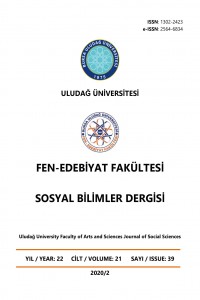Abstract
References
- Aksan, Doğan (2000). Her Yönüyle Dil Ana Çizgileriyle Dilbilim. Ankara: Türk Dil Kurumu Yayınları.
- Ercilasun, Ahmet Bican (1983). Kutadgu Bilig Grameri -Fiil-. Ankara: Gazi Üniversitesi Yayınları.
- Banguoğlu, Tahsin (2011). Türkçenin Grameri. Ankara: Türk Dil Kurumu Yayınları.
- Bilgegil, Kaya (2009). Türkçe Dilbilgisi. Erzurum: Salkımsöğüt Yayınları.
- Boz, Erdoğan (2007). Türkiye Türkçesinde +{A} Durum Biçimbirimi. Ankara: Gazi Kitabevi.
- Bozkurt, Fuat (2010). Türkiye Türkçesi. Ankara: Kapı Yayınları.
- Chomsky, Noam (2011). “Dil ve Zihin”. Çev: Ahmet Kocaman, Ankara: BilgeSu Yayıncılık.
- Demirci, Kerim (2010). “Derin Yapı ve Yüzey Yapı Kavramlarından Ne Anlıyoruz?”. Turkish Studies, C. 5, S. 4, s. 291-304.
- Deny, Jean (2012). Türk Dili Grameri. Çev: Ali Ulvi Elöve. İstanbul: Kabalcı Yayınevi.
- Doğan, Gürkan (1990). “Bir Edimbilim Kuramı Olarak Bağıntı”. Dilbilim Araştırmaları, Ankara: Hitit Yayınevi.
- Ediskun, Haydar (2010). Türk Dilbilgisi (Ses Bilgisi - Biçim Bilgisi, Cümle Bilgisi). İstanbul: Remzi Kitabevi.
- Ergin, Muharrem (2006). Türk Dil Bilgisi. İstanbul: Boğaziçi Yayınları.
- Gencan, Tahir Nejat (2007). Dilbilgisi. Ankara: Ağaç Yayınları.
- Hacıeminoğlu, Necmettin (1991). Türk Dilinde Yapı Bakımından Fiiller. Ankara: Kültür Bakanlığı Yayınları.
- Kıran, Zeynel ve Ayşe Eziler Kıran (2013). Dilbilime Giriş. Ankara: Seçkin Yayınevi.
- Korkmaz, Zeynep (1966). “Kabus-name ve Marzuban-name Çevirileri Kimindir?”. Türk Dili Araştırmaları Yıllığı Belleten, s. 267-278.
- ---------------------- (2003). Türkiye Türkçesi Grameri -Şekil Bilgisi-. Ankara: Türk Dil Kurumu Yayınları.
- ---------------------- (2017). Marzuban-nâme Tercümesi, Destûr-ı Şâhî. Ankara: Türk Dil Kurumu Yayınları.
- Şahin, Hatice (2001). “Kutadgu Bilig’de Tasvirî Fiiller”. Uludağ Üniversitesi Fen-Edebiyat Fakültesi Sosyal Bilimler Dergisi, C. 2, S. 2, s. 95-105.
- Ullmann, Stephen (1978). “Semantics (Anlambilimi)”. Türk Dili Mecmuası 38, 322 (1978): 355. Frank Robert Palmer, Semantics -A New Outline-, Semantik -Yeni Bir Anlambilim Projesi- Çev: Ramazan Ertürk, (Ankara: Kitabiyat, 2001).
- Üstünova, Kerime (2010). “Yüzey Yapı - Derin Yapı Kavramları Üzerine”. Turkish Studies, C. 5, S. 4, s. 697-704.
- Yılmaz, Engin (2014). Temel Dilbilgisi Terimleri Sözlüğü. Ankara: Pegem Akademi Yayınları.
Abstract
When the historical Turkish dialects are examined, the meaning value is loaded with the other verb bearing the verb that many verbs such as giving, wanting, knowing, coming, being. This situation also applies to Turkey in Turkish. There are depictional verb structures that have been included in the historical dialects and have lost their functioning or have very different meanings than today. For this reason, the variability in the form unit, word unit and semantic plane of some compound verbs in Marzubannâme is quite remarkable. In this study, after briefly mentioning about Marzubannâme, information is given about the combined verb and its usage in Turcology. Since the main purpose of the study is to examine the semantic plane of some compound verb structures in Marzubannâme, by referring to the concepts of deep structure and surface structure, which are two basic aspects of semantic science, name-verb established with the help of -mAk iste-, -mAk ol, established with the help of the adjective -AcAk ol-, -mIş ol-, (eğer) + -sA structure and adjective verb -AsI ol-, the verb established with the help of the verb structures are examined in both form unit, word unit and semantic plane and their frequency of use in the text is presented. Thus, the semantic plane of these structures used in today's Turkish and those that have undergone semantic change and those not used in today's Turkish have been tried to be presented.
Keywords
References
- Aksan, Doğan (2000). Her Yönüyle Dil Ana Çizgileriyle Dilbilim. Ankara: Türk Dil Kurumu Yayınları.
- Ercilasun, Ahmet Bican (1983). Kutadgu Bilig Grameri -Fiil-. Ankara: Gazi Üniversitesi Yayınları.
- Banguoğlu, Tahsin (2011). Türkçenin Grameri. Ankara: Türk Dil Kurumu Yayınları.
- Bilgegil, Kaya (2009). Türkçe Dilbilgisi. Erzurum: Salkımsöğüt Yayınları.
- Boz, Erdoğan (2007). Türkiye Türkçesinde +{A} Durum Biçimbirimi. Ankara: Gazi Kitabevi.
- Bozkurt, Fuat (2010). Türkiye Türkçesi. Ankara: Kapı Yayınları.
- Chomsky, Noam (2011). “Dil ve Zihin”. Çev: Ahmet Kocaman, Ankara: BilgeSu Yayıncılık.
- Demirci, Kerim (2010). “Derin Yapı ve Yüzey Yapı Kavramlarından Ne Anlıyoruz?”. Turkish Studies, C. 5, S. 4, s. 291-304.
- Deny, Jean (2012). Türk Dili Grameri. Çev: Ali Ulvi Elöve. İstanbul: Kabalcı Yayınevi.
- Doğan, Gürkan (1990). “Bir Edimbilim Kuramı Olarak Bağıntı”. Dilbilim Araştırmaları, Ankara: Hitit Yayınevi.
- Ediskun, Haydar (2010). Türk Dilbilgisi (Ses Bilgisi - Biçim Bilgisi, Cümle Bilgisi). İstanbul: Remzi Kitabevi.
- Ergin, Muharrem (2006). Türk Dil Bilgisi. İstanbul: Boğaziçi Yayınları.
- Gencan, Tahir Nejat (2007). Dilbilgisi. Ankara: Ağaç Yayınları.
- Hacıeminoğlu, Necmettin (1991). Türk Dilinde Yapı Bakımından Fiiller. Ankara: Kültür Bakanlığı Yayınları.
- Kıran, Zeynel ve Ayşe Eziler Kıran (2013). Dilbilime Giriş. Ankara: Seçkin Yayınevi.
- Korkmaz, Zeynep (1966). “Kabus-name ve Marzuban-name Çevirileri Kimindir?”. Türk Dili Araştırmaları Yıllığı Belleten, s. 267-278.
- ---------------------- (2003). Türkiye Türkçesi Grameri -Şekil Bilgisi-. Ankara: Türk Dil Kurumu Yayınları.
- ---------------------- (2017). Marzuban-nâme Tercümesi, Destûr-ı Şâhî. Ankara: Türk Dil Kurumu Yayınları.
- Şahin, Hatice (2001). “Kutadgu Bilig’de Tasvirî Fiiller”. Uludağ Üniversitesi Fen-Edebiyat Fakültesi Sosyal Bilimler Dergisi, C. 2, S. 2, s. 95-105.
- Ullmann, Stephen (1978). “Semantics (Anlambilimi)”. Türk Dili Mecmuası 38, 322 (1978): 355. Frank Robert Palmer, Semantics -A New Outline-, Semantik -Yeni Bir Anlambilim Projesi- Çev: Ramazan Ertürk, (Ankara: Kitabiyat, 2001).
- Üstünova, Kerime (2010). “Yüzey Yapı - Derin Yapı Kavramları Üzerine”. Turkish Studies, C. 5, S. 4, s. 697-704.
- Yılmaz, Engin (2014). Temel Dilbilgisi Terimleri Sözlüğü. Ankara: Pegem Akademi Yayınları.
Details
| Primary Language | Turkish |
|---|---|
| Subjects | Linguistics |
| Journal Section | Articles |
| Authors | |
| Publication Date | July 31, 2020 |
| Published in Issue | Year 2020 Volume: 21 Issue: 39 |

